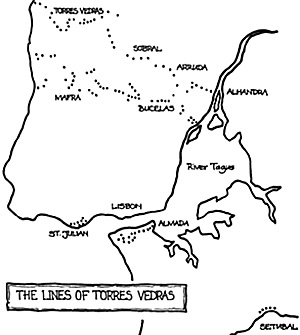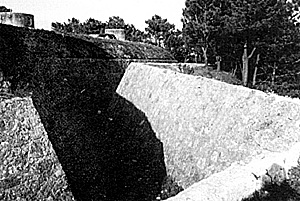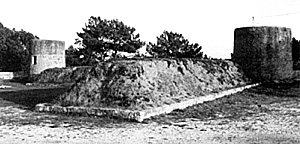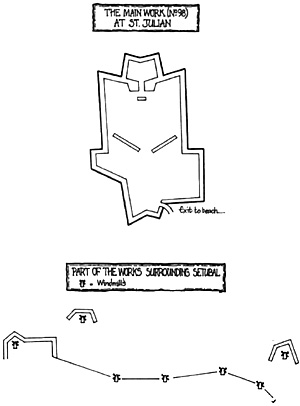 The two great chains of defences north of Lisbon
have received considerable attention from
historians. The third chain of the Lines of Torres
Vedras, around the small bay of St. Julian south of
the capital has, on the other hand, all too frequently
been ignored.
The two great chains of defences north of Lisbon
have received considerable attention from
historians. The third chain of the Lines of Torres
Vedras, around the small bay of St. Julian south of
the capital has, on the other hand, all too frequently
been ignored.
In some respects the third line was the most vital of them all. This was to be the British army's secure embarkation point. If Wellington had been unable to persuade the British cabinet that he could safely withdraw the army in the event of a serious defeat he would not have been granted permission to attempt the defence of Portugal.
Such was the anxiety of the Government for the safety
of the army in the Spring of 1810 that the Secretary of State
for War was obliged to tell Wellington "that a very
considerable degree of alarm exists in this country
respecting the safety of the British army in Portugal".
Wellington's plans for a safe evacuation, therefore, were a
prominent feature of his dispatches during this period. He
informed Lord Liverpool that if he were provided with a
"large fleet of ships of war, and 45 disposable tons of
transports, I shall try , and I think I shall bring them (the
British army) all off". [1]
This did not allay Liverpool's fears, who replied that
"the chances of a succesful defence are considered
here by all persons, military as well as civil, so improbable that I could not recommend any attempt at what may be called desperate resistance".
[2]
He consequently advised Wellington that he would
"be excused for bringing away the army a little too
soon, than, by remaining in Portugal a little too long,
exposing it to those risks from which no military operations can be wholly exempt".
To this, Wellington replied that "all the preparations for
embarking and carrying away the army, and everything
belonging to it, are already made, and my intention is to
embark it, as soon as I find that a military necessity exists
for so doing. I shall delay the embarkation as long as it is in
my power, and shall do everything in my power to avert the
necessity of embarking at all.
If the enemy should invade this country with a force less than that I should think so
superior to ours as to create a necessity of embarking, I shall fight a battle to save the country, for which I have made the preparations; and if the result
should not be successful, of which i have no doubt, I shall
still be able to retire and embark the army .... (However),
if we do go, I feel a little anxiety to go like gentlemen, out
of the hall door (particularly after all the preparations I
have made to enable us to do so), and not out of the back
door". [3]
Wellington had indeed made his plans to "go like
gentlemen". As early as October 1809, Wellington had
reminded Colonel Fletcher, his chief engineer that "the
great object in Portugal is the possession of Lisbon and
the Tagus, and all our measures must be directed to that
object. There is another also connected with that first
object, to which we must attend, viz., the embarkation of
the British troops in the case of a reverse".
[4]
Because of the rocky nature of the coast of
Portugal there are very few spots suitable for such a
major operation, and only four places were given any
serious consideration. Admiral Berkely, who commanded
the Royal Navy squadron stationed in the Tagus,
suggested the little bay of Paco d'Arcos. Wellington
rejected this as it was within artillery range from the
south bank of the Tagus, and it was Wellington's firm
belief that the French would "attack on two distinct lines,
the one south, the other north, of the Tagus."
[5]
The second place to be investigated was Peniche.
This was a small peninsula some forty miles north of
Lisbon. It was already strongly fortified and was virtually
impregnable. In December 1809, Peniche was inspected
by Marshal Beresford's chief of staff: "The isthmus over
which the peninsula is approached is covered with water
at high tide, and from the line of works describing a sort of
arc, very powerful cross-fires may be established on
every part of it. There are nearly 100 good guns upon the
work, the brass ones especially good. This is the most
favourable position that can be conceived for embarking
the British army, should it ever be necessary to do so. The
circumference abounds with creeks and clefts in the
rocks, inside which there is always smooth water, and
easy egress for boats. They are out of reach of fire from
the mainland: indeed, there is sufficient room to encamp a
large force perfectly beyond the enemy".
[6]
Peniche was favoured by the British
Government who saw it as a second Gibraltar which
"might be held by England, even if Portugal otherwise
were in the power of the enemy... If it be the wish of
Lord Wellington he can retire upon Lisbon, give battle in
front of it, and if the day go against him. Retreat upon
Peniche and defend it so long as he pleases".
[7]
Wellington knew that he could hold Peniche
against attack almost indefinately. But if the French attack
was delivered between June and November, when the
Tagus was fordable, the allied army could well be forced
to withdraw eastwards for fear of of exposing its flank. A
retreat to Peniche would then be impossible. In addition,
the main Lines of Torres Vedras were only twenty-two
miles north of Lisbon and Peniche would be well outside
these defences. For this reason, despite its obvious
strengths, Peniche was discounted as the final embarkation point.
As none of these places was regarded as being
satisfactory, Wellington instructed Colonel Fletcher to
investigate the coast line South of Lisbon. Fletcher
reported that the small bay of St. Julian, was far from
ideal:. "at intervals, such a sea rolls in for days together
that no boat can with safety approach the shore". It could,
however, be made secure enough to allow an
uninterrupted embarkation. Just a few miles below the
capital, the bay was partially sheltered by a rocky
promontory. Upon this was built the Sixteenth century fort of
Sao Juliao de Barra. This fort "from its extravagantly high
scarps and deep ditches", recorded Major John Jones,
Fletcher's second-in-command, "can never be successfully
assaulted against the slightest opposition".
[8]
[1] Gurwood, J. (Ed.) The Dispatches of Field Marshal
the Duke of Wellington, 1835-38, vol. 5, pp.446-9.
Appendix: Works Comprising the Lines of Torres Vedras (Charts: slow: 177K)) Campaign in Portugal: Part II (AoN27) Many of the redoubts of the Lines were originally constructed
entirely from earth, but after the first winter it was found that with any face that
was cut at an angle greater than 45 degrees the soil was washed away by heavy
rain.
Many of the redoubts of the Lines were originally constructed
entirely from earth, but after the first winter it was found that with any face that
was cut at an angle greater than 45 degrees the soil was washed away by heavy
rain.
 Earthen traverses were built inside many of the larger redoubts of the Lines to act as secondary defensive positions. In the background can be seen two stone-built powder rooms.
Earthen traverses were built inside many of the larger redoubts of the Lines to act as secondary defensive positions. In the background can be seen two stone-built powder rooms.
 The next place to be considered was Setubal. This
town, now an important commercial and fishing port, lies
over twenty miles south-east of Lisbon. Wellington
calculated that Setubal could be held for eight days and
would be a practical point for embarking the army. Being
on the south side of the Tagus, however, meant that
Setubal could be cut off by a French army operating in the
Alemtejo. Although it was therefore unsuitable as the main
embarkation point, Setubal was not completely ignored.
The ground around the bay was fortified and prepared as
a secondary embarkation area.
The next place to be considered was Setubal. This
town, now an important commercial and fishing port, lies
over twenty miles south-east of Lisbon. Wellington
calculated that Setubal could be held for eight days and
would be a practical point for embarking the army. Being
on the south side of the Tagus, however, meant that
Setubal could be cut off by a French army operating in the
Alemtejo. Although it was therefore unsuitable as the main
embarkation point, Setubal was not completely ignored.
The ground around the bay was fortified and prepared as
a secondary embarkation area.
Notes
[2] Supplementary Dispatches and Memoranda of Field
Marshal the Duke of Wellington, 1858-72, vol. 6, p.463.
[3] Dispatches, vol. 6, pp.6-7.
[4] Dispatches, vol. 5, p.235.
[5] Ibid.
[6] B. Durban, The Peninsular Journal of Major-General Sir
Benjamin Durban, 1930, p.74.
[7] Wellington wrote the following to Admiral Berkely from
Lisbon on 26 October 1809: Peniche - I conceive that I
should be able to hold this place during any length of time
that might be necessary for an embarkation; but ... in the
event of the attack being made between the months of June
and November, when the Tagus is fordable, the operations
of the army would be carried on in a part of the country
which would be cut off from Peniche and the retreat to that
place would be impracticable...
[8] J. Jones, Memoranda Relative to the Lines Thrown up to
Cover Lisbon in 1810, 1846, p.5.
Back to Age of Napoleon 26 Table of Contents
Back to Age of Napoleon List of Issues
Back to MagWeb Master List of Magazines
© Copyright 1998 by Partizan Press.
This article appears in MagWeb (Magazine Web) on the Internet World Wide Web.
Other military history articles and gaming articles are available at http://www.magweb.com